Imagine stepping into your backyard and plucking fresh, flavorful nuts straight from your trees. Sounds rewarding, right? But here’s the problem, not all nut trees are created equal. Some thrive effortlessly, while others demand constant care or simply won’t grow in your climate.
Choosing the wrong tree can mean years of frustration and wasted effort. The good news? With the right guidance, you can grow nut trees that are both productive and low maintenance. Whether you’re dreaming of buttery pecans, sweet chestnuts, or crunchy hazelnuts.
This guide will help you pick the best nut trees for your yard and steer clear of the ones that aren’t worth your time. Let’s turn your yard into a nut lover’s paradise.
1. Chinese chestnut (Castanea mollissima)
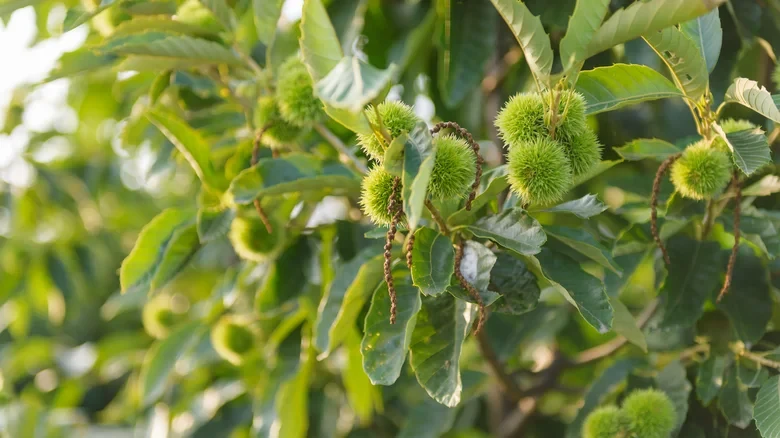
Growing a Chinese chestnut tree in your yard can be a rewarding experience. Known for its resistance to chestnut blight, this tree thrives in well-drained soil and full sun. It produces sweet, edible nuts that are encased in spiny burrs, which split open when ripe. The tree itself is visually appealing, with a broad canopy that provides ample shade.
Chinese chestnuts are relatively low maintenance, requiring minimal pruning and care once established. They also attract wildlife, making your yard a haven for birds and squirrels. This tree is suitable for larger spaces with a mature height of 40 to 60 feet. Its nuts are delicious and nutritious, packed with vitamins and minerals. If you’re looking for a tree that combines beauty, utility, and resilience, the Chinese chestnut is an excellent choice.
Also, the tree’s fall foliage adds a splash of golden yellow to your landscape, making it a year-round asset. While it may take a few years to start producing nuts, the wait is well worth it for the bounty it eventually provides.
2. European chestnut (Castanea sativa)
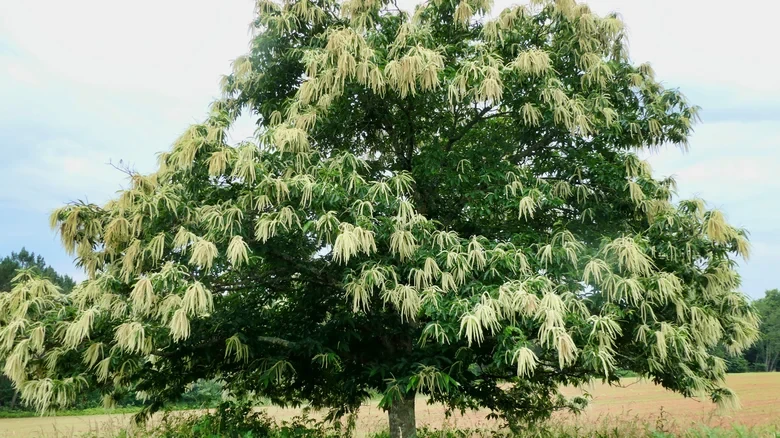
The European chestnut, also known as the sweet chestnut, is a classic choice for nut enthusiasts. This tree prefers acidic, well-drained soil and thrives in temperate climates. It can grow up to 100 feet tall, making it a striking addition to any landscape.
The nuts are larger than those of the Chinese chestnut and are often roasted or used in cooking. European chestnuts have a rich history, having been cultivated for centuries in Europe. They are also resistant to many pests and diseases, though they can be susceptible to chestnut blight in some regions.
The tree’s broad leaves and stately appearance make it a standout feature in any yard. If you have the space and the right conditions, the European chestnut is a timeless and productive option. Its nuts are not only a treat for humans but also attract wildlife, adding life and activity to your outdoor space
3. Pecan tree (Carya illinoinensis)
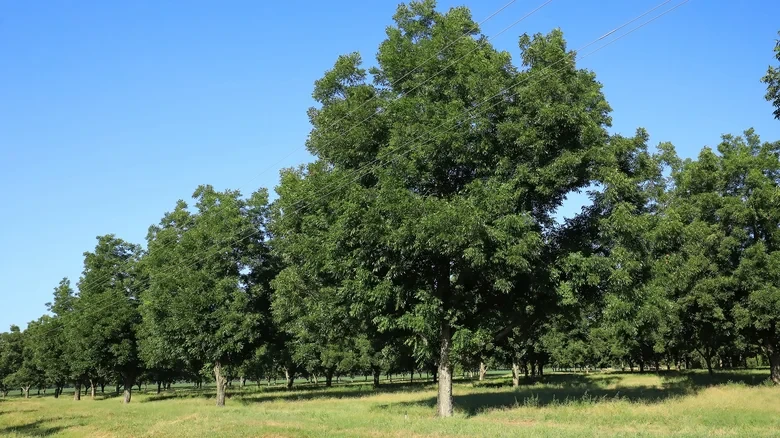
Pecan trees are a favorite for those who enjoy fresh, buttery nuts. Native to the southern United States, these trees require deep, fertile soil and plenty of sunlight. They can grow quite large, often reaching heights of 70 to 100 feet, so they’re best suited for spacious yards. Pecans are known for their rich flavor and are a staple in many desserts and dishes.
The tree itself is hardy and long-lived, with a lifespan that can exceed 100 years. While pecan trees take several years to start producing nuts, the wait is worth it. They also provide excellent shade and attract wildlife. If you’re patient and have the right conditions, a pecan tree can be a valuable and delicious addition to your yard. The tree’s lush foliage and towering presence make it a focal point in any landscape, while its nuts offer a tasty reward for your effort.
4. Hazelnut tree (Corylus americana)
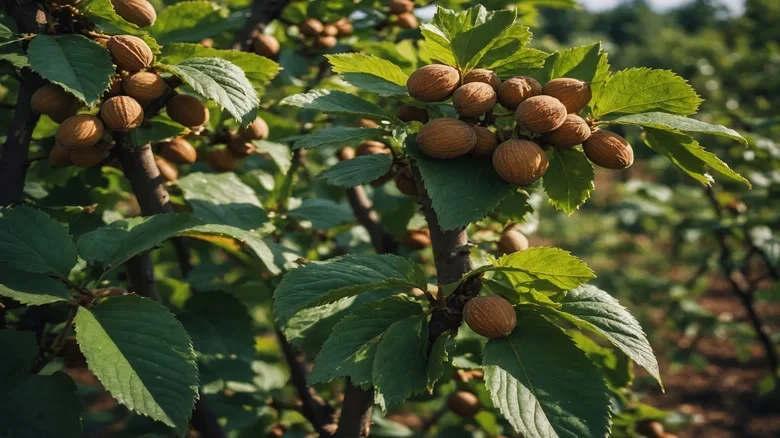
Hazelnut trees are compact and versatile, making them a great option for smaller yards. They grow well in a variety of soil types and can tolerate partial shade, though they produce more nuts in full sun. The nuts are small but packed with flavor, often used in baking and cooking. Hazelnut trees are also known for their attractive foliage and catkins, which add visual interest to your landscape.
They are relatively easy to care for and can start producing nuts within a few years. Additionally, hazelnuts are rich in healthy fats and antioxidants, making them a nutritious snack. If you’re looking for a tree that’s both practical and ornamental, the hazelnut tree is a smart choice. Its ability to thrive in diverse conditions and its quick nut production make it a favorite among gardeners. The tree’s compact size also makes it easier to manage, especially in limited spaces.’
5. American beech (Fagus grandifolia)

The American beech is a majestic tree that offers more than just nuts. While its beechnuts are small and edible, they are a valuable food source for wildlife. This tree prefers well-drained, acidic soil and can grow up to 80 feet tall. Its smooth, gray bark and dense foliage make it a standout in any yard.
American beech trees are slow-growing but long-lived, often surviving for centuries. They provide excellent shade and are relatively low-maintenance once established. The nuts, though small, are rich in nutrients and can be eaten raw or roasted. If you’re looking for a tree that combines beauty, longevity, and ecological benefits, the American beech is a fantastic option.
Its striking appearance and ability to support local wildlife make it a valuable addition to any landscape. The tree’s fall foliage, which turns a golden bronze, adds seasonal beauty to your yard.
6. Macadamia tree (Macadamia integrifolia)

The macadamia tree is a tropical evergreen that produces some of the most sought-after nuts in the world. Native to Australia, it thrives in warm climates with well-drained soil and plenty of sunlight. These trees can grow up to 40 feet tall and have glossy, dark green leaves that add a lush look to any yard.
Macadamia nuts are known for their rich, buttery flavor and are often used in desserts and gourmet dishes. While the tree takes several years to start producing nuts, the wait is worth it for the high-quality harvest. Regular watering and protection from strong winds are essential for healthy growth.
Macadamias are also packed with healthy fats and nutrients, making them a nutritious addition to your diet. If you live in a warm climate and have the patience to wait for the nuts, this tree is a fantastic choice. Its ornamental value and delicious nuts make it a standout addition to any yard.
7. Pistachio (Pistacia vera)
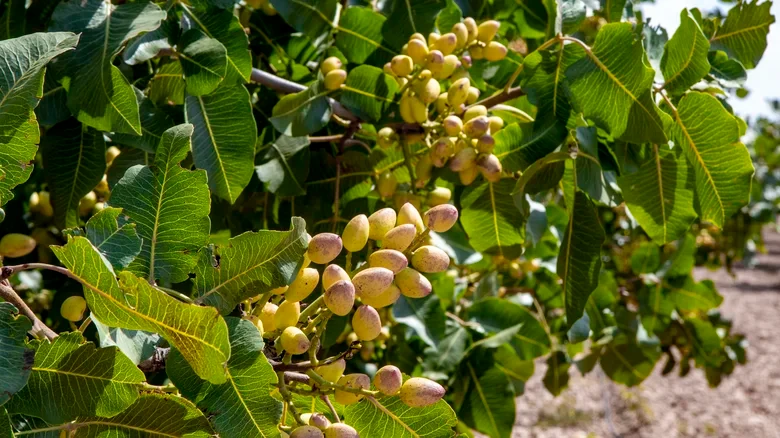
Pistachio trees are a great option for those living in arid or semi-arid regions. These trees prefer well-drained soil and plenty of sunlight, thriving in hot, dry climates. They can grow up to 30 feet tall and produce clusters of small, flavorful nuts. Pistachios are not only delicious but also rich in protein and healthy fats.
The tree itself is hardy and drought-tolerant once established, making it a low-maintenance choice for the right environment. However, pistachio trees require both male and female plants for pollination, so you’ll need to plant at least two. The nuts are encased in a hard shell that splits open when ripe, revealing the edible seed inside.
If you have the space and the right climate, a pistachio tree can be a rewarding addition to your yard. Its unique appearance and tasty nuts make it a favorite among gardeners.
8. Pinyon pine (Pinus edulis)

The pinyon pine is a small, slow-growing tree that produces edible pine nuts. Native to the southwestern United States, it thrives in dry, rocky soils and can tolerate drought conditions. This tree typically reaches heights of 10 to 20 feet, making it suitable for smaller yards.
Pinyon pine nuts are a staple in many traditional dishes and are known for their rich, nutty flavor. The tree itself is hardy and requires minimal care once established. Its compact size and evergreen foliage make it an attractive addition to any landscape. While the nuts are small, they are highly nutritious and packed with healthy fats.
If you live in a dry climate and are looking for a low-maintenance tree that produces edible nuts, the pinyon pine is an excellent choice. Its resilience and unique appearance make it a standout in any yard.
9. Red buckeye (Aesculus pavia)
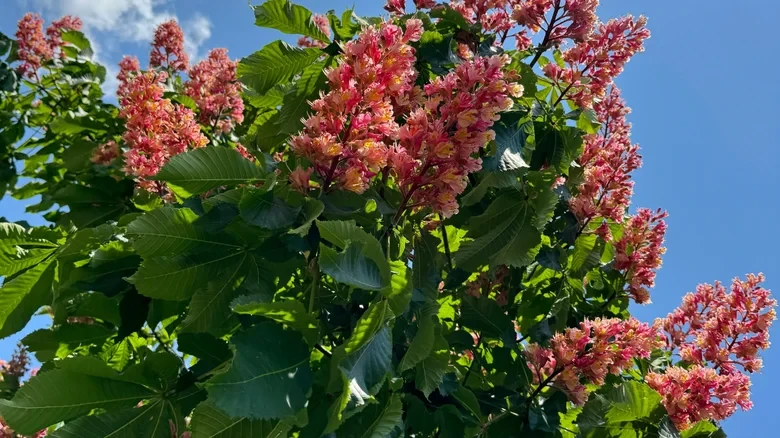
The red buckeye is a small tree or large shrub known for its striking red flowers and ornamental value. While it produces nuts, they are toxic to humans and should not be consumed. This tree thrives in well-drained soil and partial shade, making it a good option for woodland gardens.
It typically grows to about 15 feet tall and attracts pollinators like hummingbirds with its vibrant blooms. The nuts, though inedible, are a food source for wildlife. If you’re looking for a tree that adds visual interest and supports local ecosystems, the red buckeye is a solid choice.
However, if your goal is to grow edible nuts, this tree may not be the best fit. Its beauty and ecological benefits make it a worthwhile addition, but its toxicity limits its practicality for nut production.
10. Butternut tree (Juglans cinerea)

The butternut tree, also known as white walnut, produces edible nuts with a rich, buttery flavor. Native to the eastern United States, it prefers well-drained soil and full sun. This tree can grow up to 60 feet tall and has a spreading canopy that provides ample shade.
Butternuts are highly nutritious and can be eaten raw or used in cooking. However, the tree is susceptible to a fungal disease called butternut canker, which can limit its lifespan. If you’re willing to take on the challenge of managing this disease, the butternut tree can be a rewarding addition to your yard.
Its nuts are a treat for both humans and wildlife, and its stately appearance adds beauty to any landscape. While it requires some care, the butternut tree’s unique qualities make it a worthwhile choice for those with the right conditions.
11. Maybe: Black walnut (Juglans nigra)
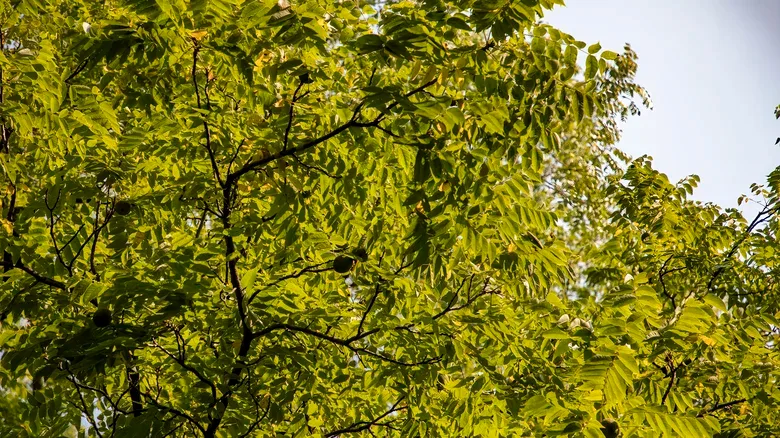
The black walnut tree is a native North American species known for its valuable timber and edible nuts. It thrives in deep, fertile soil and full sun, growing up to 100 feet tall with a broad canopy. The nuts have a rich, earthy flavor and are often used in baking or eaten raw.
However, this tree produces juglone, a chemical that can inhibit the growth of nearby plants, making it a challenging choice for mixed gardens. Black walnuts also have a thick, hard shell that requires effort to crack. While the tree is hardy and long-lived, it may not be the best option for smaller yards or those with diverse plantings.
If you have ample space and are willing to manage its allelopathic effects, the black walnut can be a rewarding addition. Its nuts are a treat, and its wood is highly prized, but its impact on surrounding vegetation is a significant consideration.
12. Skip: English walnut (Juglans regia)

English walnuts are popular for their thin shells and mild, sweet flavor, but they may not be the best choice for home growers. These trees require well-drained soil, full sun, and a long growing season with warm summers and cool winters. They are also susceptible to pests and diseases, which can make them high-maintenance. English walnut trees can grow up to 60 feet tall, requiring significant space.
They also take several years to produce a substantial harvest, which may not suit everyone’s timeline. For those in regions with shorter growing seasons or limited space, this tree might not be practical. While the nuts are delicious and versatile, the challenges of growing English walnuts often outweigh the benefits for casual gardeners.
13. Skip: Lucky nut (Cascabela thevetia)
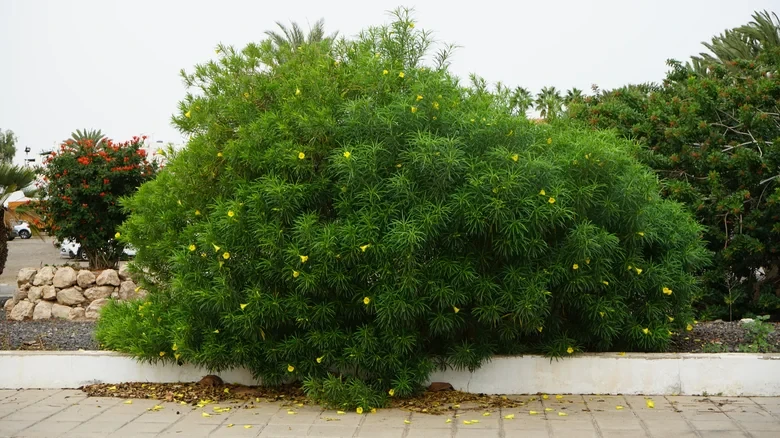
The lucky nut tree, also known as yellow oleander, is an ornamental plant with bright yellow flowers. Despite its attractive appearance, it is highly toxic to humans and animals. All parts of the tree, including the nuts, contain potent toxins that can cause severe illness or even death if ingested.
While it thrives in warm climates and well-drained soil, its toxicity makes it a poor choice for yards frequented by children or pets. The tree’s invasive nature in some regions further complicates its suitability. If you’re looking for a nut tree that’s safe and productive, the lucky nut is not the right option. Its beauty is overshadowed by the risks it poses, making it a tree best avoided.
14. Skip: Buffalo nut (Pyrularia pubera)

The buffalo nut tree is a small, understory plant native to the eastern United States. While it produces edible nuts, they are not widely consumed due to their bitter taste and potential toxicity if not prepared correctly. This tree prefers shaded, wooded areas and well-drained soil, making it less versatile for typical yard settings. Its small size and limited ornamental value further reduce its appeal.
The buffalo nut is also parasitic, relying on the roots of other trees for nutrients, which can complicate its growth in a home garden. For those seeking a nut tree that’s both productive and easy to manage, the buffalo nut is not a practical choice. Its niche growing requirements and questionable edibility make it a tree to skip.
15. Skip: Almond tree (Prunus spp.)

Almond trees are prized for their delicious nuts, but they are not well-suited for all climates. These trees require a Mediterranean-like environment with mild, wet winters and hot, dry summers. They are also prone to diseases like fungal infections and pests such as mites and borers. Almond trees need well-drained soil and consistent care, including regular pruning and irrigation.
For those in regions with cold winters or high humidity, growing almonds can be a struggle. The trees can grow up to 30 feet tall, requiring significant space. While the nuts are nutritious and versatile, the challenges of growing almond trees often make them impractical for home gardeners. Unless you live in an ideal climate and are prepared for intensive care, it’s best to skip this tree.
Final Thoughts!
Growing nut trees in your yard can be a fulfilling journey, offering both beauty and bounty. By selecting the right trees for your climate and space, you’ll enjoy fresh, homegrown nuts while adding charm to your landscape. Remember, it’s not just about planting a tree; it’s about choosing one that fits your lifestyle and environment.
Avoid the pitfalls of high-maintenance or unsuitable varieties and focus on trees that deliver results without the hassle. With a little planning and care, your yard can become a thriving nut haven. So, grab your shovel, pick your favorites, and get ready to enjoy the fruits (or nuts) of your labor!
